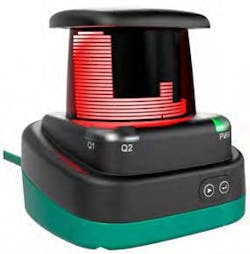A Fast, Laser-Sharp Distance Scanner For Automation Technology
Determining distances is a common metrological application in automation technology. The industrial marketplace offers many types of solutions, yet not every technology is ideal for each application. Complete, all-round visibility in fast-moving applications is what Pepperl+Fuchs touts with the North American market debut of its new R2000 UHD laser scanner.
"This IP65-rated 2D photoelectric sensor leverages pulse-ranging technology [PRT] and a rotating head to deliver quick, precise, high-resolution distance measurement, says Michael Turner, product manager—photoelectric sensing. "Combined with a gapless, 360°measuring angle and interactive wrap-around display, the result is highly reliable detection of objects to 10m and/or reflectors to 60 m, with quick visual-status indication and access to measurement data in one, compact [4.2x4.2x4.6 in.] device." Turner calls this application of pulse-ranging technology the gold standard for distance measurement sensors. "PRT is the most effective time-of-flight measurement technology available today, providing maximum precision and reliability over large distances, even in harsh ambient conditions," he says.
PRT is nothing new to the market. However, Turner says this scanner brings some unique things that haven't been seen before. "First, it has a visible red laser, eye-safe (class 1) with an extremely small light spot. As the device spins, a very small, razorsharp scan plane is created. The beam diameter at 10m range is less than 20 mm. This creates a scan plane of only ±0.05° and allows for detection of objects in extremely tight places. At the same 10-m range, most other scanners will have a light spot size of approximately 200 mm. In addition, the laser light type on other scanners normally would be infrared, which can't be seen by the human eye, so it's hard to align."
Also Read: Industrial Sensors Offer More Connectivity Options
A second important feature is the scanner's highdensity measurement capability. "Angular resolution is configurable to just 0.014°," Turner explains. "This means that a sample point is taken at increments of 0.014°. This equates to more than 250,000 scan points per second." Turner claims other scanners typically provide angular resolution of 0.2° at best. "The combination of the scanner's small light and angular resolution allows AGVs to navigate with very small reflectors down to 40 mm, even at 60-m range. This is beneficial because less reflective tape is needed, a dramatic savings in cost and installation space. Other scanners require reflectors two to three times larger."
Call 330/486-0001, email [email protected] or browse to www.pepperl-fuchs.us.
A third important attribute is that R2000 UHD is one of the smallest scanners on the market. "And the wrap-around LED display allows the user to quickly make changes to some of the internal settings," Turner says. "Also, the graphical display modes can visualize the surroundings."
These laser scanners have an adjustable scan rate up to 50 Hz (3,000 rpm) that Turner says enables them to detect protrusions or obstacles over a large area and at high speeds—ideal for material handling and ASRS applications.
Sensors with PRT emit a very short, high-intensity light pulse. They calculate object distance based on the speed-of-light constant and time-of-flight of the reflected light pulse. Unlike other time-of-flight sensors that transmit a continuous light beam, PRT sensors emit short pulses of high-intensity light up to 250,000 times per second. Compared to a continuous emitter source, the energy density of one PRT pulse can be up to 1,000 times greater. "Unlike triangulation-based sensors, the detection range of a PRT sensor isn't limited by the geometric layout of the sensor optics," Turner adds. "PRT sensors with smaller housings can be used for significantly larger detection ranges—providing impeccable measurement quality."
The scanner has a fast Ethernet interface capable of transmitting data at 100 Mbps. "Distance data is received as packets using a separate TCP/IP or UDP/ IP channel, and a simple HTTP command protocol is provided to configure the device," Turner explains.
"End users can develop software to meet their requirements. Additionally, a robotic operating system (ROS) driver is available for use with the scanner. ROS provides libraries and tools to help software developers create robot applications."
FOR MORE INFORMATION
Call 330/486-0001, email [email protected].
com or browse to www.pepperl-fuchs.us.
About the Author
Joe Feeley
Joe Feeley

Leaders relevant to this article:


